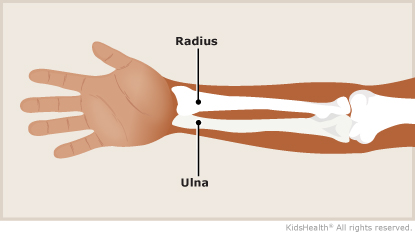A Broken Wrist: How to Care for Your Child
At today's visit, the orthopedic specialist (bone specialist) checked your child's arm and X-rays. Your child has fractures in both the radius and ulna bones at the end where they join the wrist. Your child will wear a cast while the bones heal. Healing time varies, but kids usually need a cast for 4–6 weeks. It's important to take good care of the cast to keep the skin under it healthy and avoid problems.


Daily cast care:
-
Remind your child to wiggle the fingers to keep blood circulating normally.
-
Check that the fingers have normal feeling, warmth, and color.
-
Check the edges of the cast: Make sure your child isn't picking at or removing the padding from the edges of the cast. Make sure the skin near the cast isn't scratched.
-
Don't put anything in the cast. Make sure your child doesn't put toys, food, or other objects into it.
-
Keep dirt, sand, lotion, and powder away from the cast.
-
If given a sling, your child should wear it when up and walking around. Do not let your child wear the sling while sleeping.
-
If the cast is not waterproof, keep it dry:
-
No swimming.
-
Give sponge baths to kids younger than 5 years old.
-
Older kids should take baths instead of showers.
-
Put a plastic covering over the cast when your child bathes. Put the arm and cast on something to keep them completely out of the water.
-
If the cast is accidentally splashed, gently blow air into it from a hair dryer on the cool setting.
-
If your child has a waterproof cast:
-
Your child can swim and bathe without covering the waterproof cast.
-
Once a day, and after bathing or swimming:
Problems to watch for:
-
Sharp cast edges: Put tape or moleskin (available at drugstores) on any rough spots.
-
Itching: Tap lightly on the cast or use a hair dryer on the cool setting to blow air in and around the edges. Don't let your child scratch under the cast or put anything into it.
-
Swelling: If the fingers look puffy, raise the arm above the level of the heart for 1 hour. If the swelling doesn't get better, call your health care provider.
If your child has pain:
-
When your child is awake, apply ice in a plastic bag wrapped in a towel on the outside of the cast for 20 minutes every 3 hours for up to 2 days. Don't put ice directly on the cast or skin.
-
You can give medicine for pain if your health care provider says it's OK. Use these medicines exactly as directed:
-
acetaminophen (such as Tylenol® or a store brand)
-
OR
-
ibuprofen (such as Advil®, Motrin®, or a store brand). Do not give ibuprofen to babies under 6 months old.
Be sure to:
-
Follow up with the orthopedic specialist as recommended.
-
Have your child avoid gym class, sports, and playground equipment and activities until the orthopedic specialist says it's OK.

-
Your child's pain continues while taking pain medicine.
-
The pain becomes worse, especially when your child stretches out the fingers.
-
Your child's fingers stay swollen even after propping up the arm for 1 hour.
-
Your child develops a fever without an obvious cause (like an ear infection or sore throat).
-
Your child is fussy or cranky and you can't tell why.
-
The skin around the cast looks red or raw.
-
The cast feels too tight or too loose.
-
The cast is damaged or smelly, or a non-waterproof cast gets wet.
-
You think something got inside the cast.

-
Your child's hand becomes tingly, numb, cold, blue, or pale.

What are the radius and ulna bones? They are the bones in the lower arm. The ulna is on the little finger (pinkie) side. The radius is on the thumb side.
What causes arm fractures? Often, arm fractures happen when kids hold out their arms to stop a fall. The pressure on the bone causes it to crack, usually at the end near the wrist.
What does the cast do? The cast is made of fiberglass or plaster with soft padding inside. It supports and protects the broken bones while they heal. It might feel snug, but it shouldn't feel too tight or painful. It can feel heavy, so your child might wear a sling around the neck and over the cast for support.